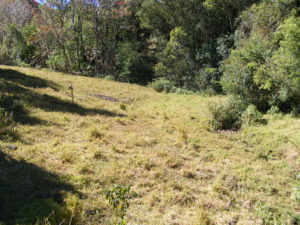During periods of prolonged drought a number of key landscape indicators become more apparent and these can greatly assist you to make better decisions on the productive uses of your land and to make better provisions for future drought events.
Most notably, can you see any places in the landscape where the grass and/or other plants are still healthy green and thriving naturally. This will indicate where there is still water available near the surface, it could be from a natural spring seeping or a contour trench/swail that captured water during the last decent rainfall and has slowly been soaking into the soil downhill. These locations can be termed drought proof microclimates and make exceptional locations for productive plants, such as fruit, nut and forage trees, vegetable gardens, orchards and poultry foraging areas. These existing drought proof microclimates can also be further enhanced and expanded upon with the addition of contour trenches extending out from the lush zone and additional plantings of perennial vegetation located along their lower banks.
You’ll also observe that where there is still a mixed ecology of perennial vegetation including groundcovers, bushes, shrubs, trees and vines, the impact of the drought is nowhere near as significant due to the deeper roots, canopy providing partial shade and no soil being exposed to the drying sun and accompanying wind erosion. If you have soil that has been ploughed in recent times, go and have a close inspection of how this compares to adjacent soil that was not ploughed, You’ll find that soil that was not disturbed, but instead has perennial vegetation growing it, is far less susceptible to drying out and is more able to conserve its water resources (Much of it in the vegetative mass) and maintain the symbiosis of a much more resourceful, deeper rooted and moisture harvesting vegetation community living upon it.
The strategy of broadcasting seeds directly into mulch on unplowed soil is making a significant comeback due to its many advantages in time, energy efficiency and in getting crops planted into optimal growing conditions. This strategy combines no-tillage with utilizing the mulch of previous crops, companion planting is built into the broadcasting blend and the seeds are distributed to their optimal density relative to the existing living ground covers. Many cropping species such as Amaranth, chia, millet, Quinoa, Asian greens, turnips, sweeds, radishes, leucerne and many more are very suitable to this easy style of cultivation.
The range of plant species that you can observe still thriving during drought periods can give you insights into structurally similar or directly related production plants that could be employed to replace weeds. For example,
Sweet potato, warrigal greens and pepino can replace low growing grasses;
Pak choi and amaranth can replace fire weed and farmers friends;
Cassava and Abika can replace lantana and croften weed;
Choko and passionfruit can replace corky passionflower and balloon vine;
Ice cream bean and Tamarind can replace coral trees
Pigeon pea can replace cassias;
Tamarillo can replace wild tobacco;
Mullberries and saba nuts can replace privot;
Mangos and Avocados can replace camphor laurel and so forth..
The flow of the land or Topography is also very significant when it comes to efficient systems design and functional land use. The gullies and ridge lines are the wet and dry contrasting microclimates that can be utilized for specific crops. For example, Pecan nuts love the damp gullies and Carob beans love the free draining ridge tops. As you follow the gullies to their highest points on your land, strategic places for high perched dams reveal themselves, locations where there is natural catchment and plenty of width and depth for an effective dam wall to be installed. By locating dams as high up in the landscape as possible, the ease and simplicity of high-volume gravity-feed irrigation to anywhere on your property becomes one of the greatest resources and infrastructure features to further drought proof/ maintain high production through all seasonal extremes.
Alluvial creek/river flats are also very prominent during drought times. These areas maintain fertility due mainly to ground moisture that is available via a high water table. Many agrarian cultures though out history have utilized these fertile niches in the landscape for production, through the digging of drainage trenches and making raised beds to even out the extremes of periodic flooding, these sites can be amongst the most prolific production areas with very little need for any additional irrigation.
Rainwater storage tanks are another worthy consideration in the drought proofing strategies arena. How well is your drinking water reserve holding up to the task of supplying your needs during prolonged drought? Often there is room available next to existing tanks to add another one or more to overflow into each other during heavy rain and make the most of these precious bountiful events.
The availability of adequate water reserves to sustain productivity through a drought is the single most important asset required for any farm or garden to remain viable and resilient through these regular recurring events. Running out of water during these critical times should be a call to better planning and to safeguard against crop failures and the death or need to sell off livestock at low market prices. As with so many environmental challenges confronting us, we have the resources, we have access to appropriate technology, it’s now an opportunity for our creative intelligence to learn from what nature reveals to us and to design systems and develop methods that are in alignment with natural processes and produce reliable results with ease!
Spring is one of the best times of the year to make a new productive plan for your farm or garden and during a drought the indicators are at their best for guiding us on how to utilize our land and its resources to its best potential.

Opportunity during a drought
Recent Comments